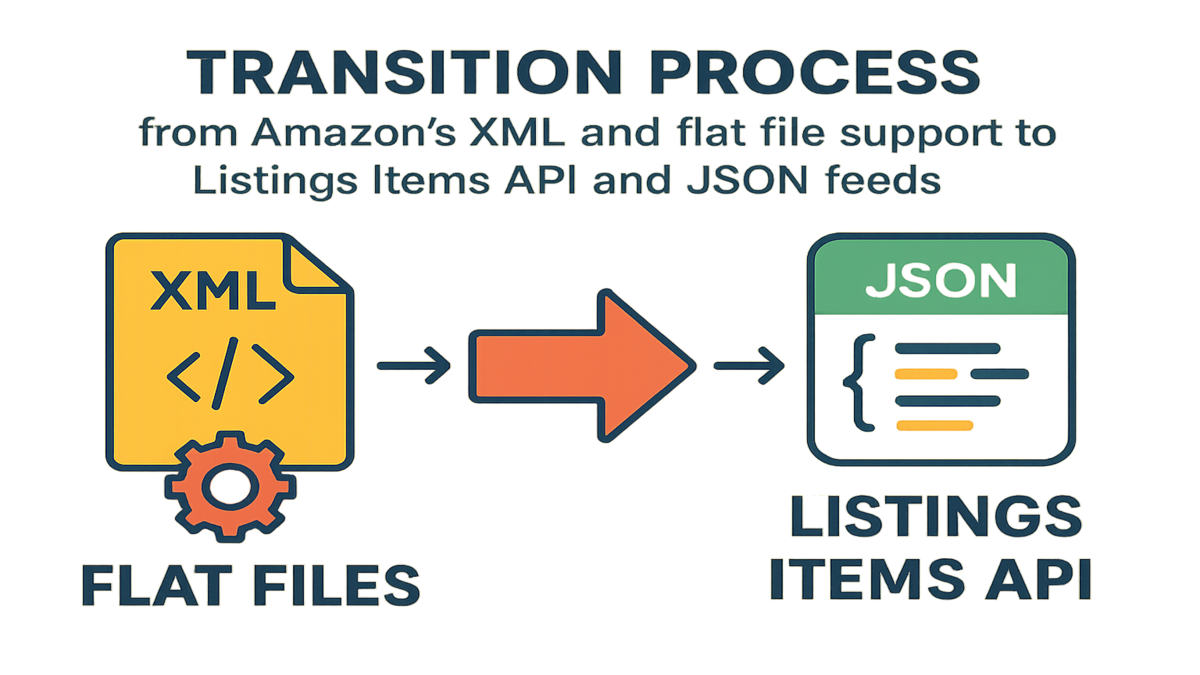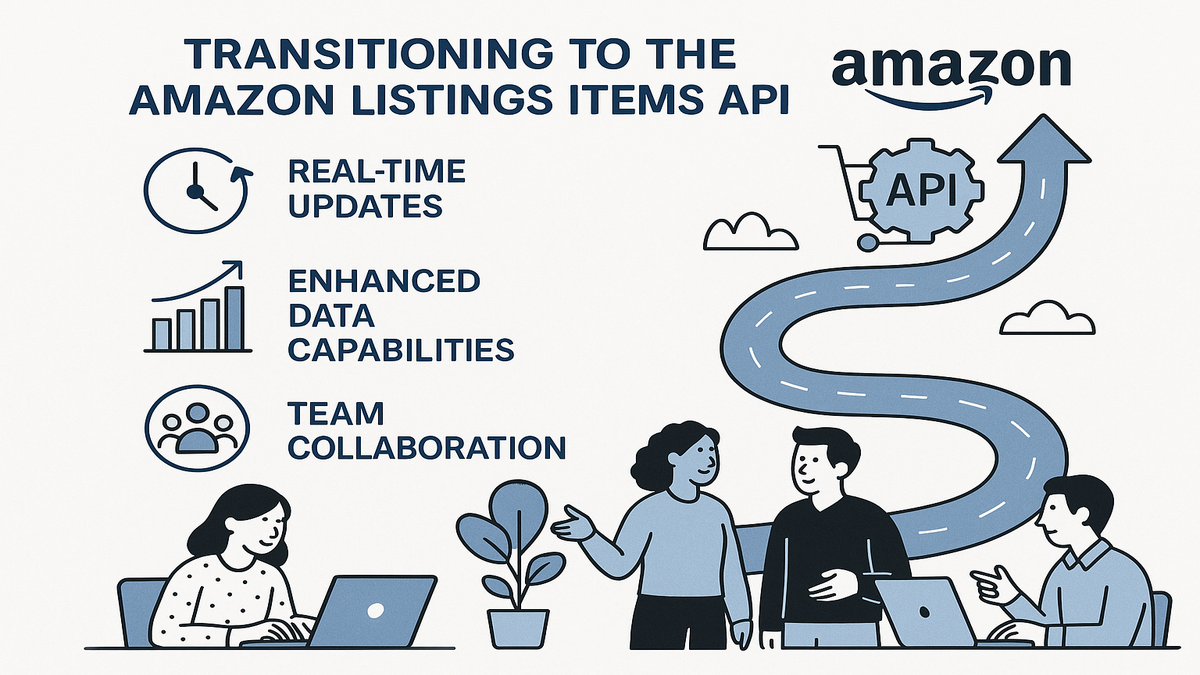
Amazon's Feeds API: Deadline Hits July 2025

Why You Need To Update Your Feeds API Strategy Right Now
So you’re coasting along with your Amazon Feeds API and then—whack! And all of a sudden there’s a new sheriff in town, and you have a date with destiny: July 31, 2025. That’s the day Amazon will flip the switch and remove their XML and flat file support for product feeds. If you’ve been sleeping on this update, it’s time to wake up as your normal routines hang in the balance.
Do you love surprises? Absolutely not, certainly not when it comes to your business. This isn’t a modest adjustment; it’s a profound strategic shift. With old Feed going to the graveyard, transitioning to Listings Items API or JSON feeds is not optional — it’s survival. And here's the silver lining. You even have time to get out ahead of this, and it’s right now.
TL;DR
- Amazon to retire XML and flat file feeds by July 31, 2025.
- Move to Listings Items API (or JSON feeds) in order to continue functioning.
- Use Amazon's resources online to make a smooth switch.
- Failure to heed the update might leave you out of selling power after the deadline.
Begin strategizing your migration now.

Understanding the API Transition
What’s Being Phased Out
Let's get specific. Here is a BREAKING CHANGE: Removal of Product Feeds On July 31, 2025, the following feed types will be retired: POSTPRODUCTDATA, POSTINVENTORYAVAILABILITYDATA, POSTPRODUCTPRICINGDATA, and others. Need the full list? Visit the Amazon migration page.
But it’s not all bad news. We are moving to JSON. Why? This is because JSON feeds are more flexible and less complex. It’s like getting rid of your trusty old typewriter for a shiny new laptop — this is a serious upgrade.
JSON, and why Listings Items API?
So, JSON and the Listings Items API, you’re seeing even greater capabilities. They are modern solutions, fast and can scale. Per Amazon developer guides You can simplify your workflow using JSON feeds to allow bulk updates and maintain nuanced clarity in your product data.
“This transition is intended to make integrations easier and more flexible for developers,” an Amazon engineer was quoted as saying. So, if you want to keep up with businesses that are thriving in the digital age, this is where you want to be.
Why It Matters
The Danger of Lagging Behind
Hanging onto the old system until the very last is a recipe for disaster — operational blackouts at the worst possible time. You don’t want to be the seller who suddenly finds transactions grinding to a halt because your feed types can’t process.
(The resistance to change can really spoil a party.) Remember Kodak? They missed the digital photography bus. Your competitors are not going to wait for you to catch up. You know what they say — you snooze, you lose.
The Benefits of Migration
The Listings Items API doesn’t only keep you in the game; it raises it up a notch. You get richer data capabilities, real-time updates, and better integration with other Amazon services. It’s like going from a tricycle to a bullet train.
Think of Netflix's unsuccessful pitch to sell to Blockbuster. Don’t be the Blockbuster of your industry; hop on board soon to claim your piece of the pie.

The Roadmap to Success
Step 1: Educate Yourself
To begin, waltz through the listings management how-tos, webinars, and demonstration videos Amazon offers. These tools dismantle the complex act of migrating into manageable tasks in a world where complexity has been made simple. Consider it Amazon providing you with a cheat sheet.
Step 2: Test and Adapt
Mix a decisive phase into your strat. Try the new APIs, adjust based on feedback, and iterate. It’s about braiding the old and new practices into a hybrid approach until July 2025. Embrace your inner scientist — experiment, fail, learn, repeat.
Task 3: Engage & Act
Get your team on board. Teamwork is the secret for smooth functioning. Companies that engaged with their development teams at a fast clip had an easier time transitioning and made few missteps, according to Amazon. Consider this a team sport; a single serve isn’t going to do the trick here.
Visit our Case Studies and see how other companies managed their API move effectively.
Mid-Migration Recap
Be sure to know what’s mandatory by 2025.
- Access education resources such as webinars and guides.
- Iterate based on pilot testing and the Listings API.
- Ensure that your full team is on the same page to collaborate effectively.
FAQs
1. Why did Amazon retire XML and flat files?
Amazon would like to update and harmonize the data processes against more scalable JSON formats.
2. After July 31, 2025, can I use my old "feeds" too?
No, all integrations need to be migrated to Listings Items API/JSON feeds by this date.
3. How can I get more support around migration?
Check out Amazon’s development resources or ask a question to experts on Amazon’s forums.
4. Is the JSON feed solution better for every seller?
JSON feeds are more capable, but ideal for those who can operate at scale and speed.
5. What if I have problems after I have migrated?
Consult Amazon’s own troubleshooting articles or contact their support for help.
Travel Without Fear
- Read Amazon’s migration guides and resources DETAILED!
- Create a timetable and benchmarks for July 2025.
- Pilot—Listings Items API Testing parties.
- Collect feedback, and adapt accordingly to make a smooth transition.
As we tick down the days until D-Day, consider this migration not so much a deadline as it is a fresh start. Now, align with Amazon’s future-proof APIs and turn potential headaches to executing winning strategies effectively. For more tips and winning methods, visit our Features page.
Ready to speed up your migration? So hop on to Amazon’s migration resources and make sure your business doesn’t only make it, but grows! For a more in-depth look, see our Ultimate Guide to SP-API.

